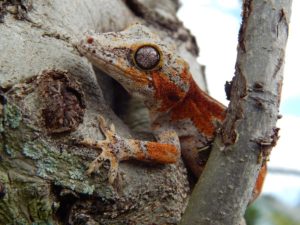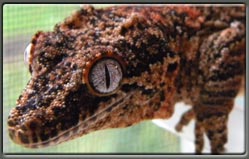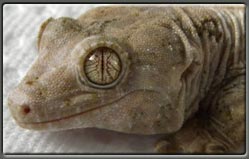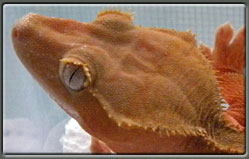
 Gargoyle Geckos are a medium to large sized member of the Rhacodactylus genus from the southern region of Grande Terre. Their comon name, gargoyle, comes from the bumps (horns) located at the top of the skull. Their scientific name, auriculatus, refers to the small bony structure present over their ear opening.
Gargoyle Geckos are a medium to large sized member of the Rhacodactylus genus from the southern region of Grande Terre. Their comon name, gargoyle, comes from the bumps (horns) located at the top of the skull. Their scientific name, auriculatus, refers to the small bony structure present over their ear opening.
Gargoyle Geckos are a nocturnal species that will spend all day sleeping. They are very vocal at night and it is not uncommon to hear barks, squeaks, and growls as they talk to each other. Gargoyle Geckos are known for being very easy to handle, though some may gape their mouths when first picked up. They tend to be less flighty than Crested Geckos, and will often sit calmly with gentle handling.
Gargoyle Geckos are generally found on the lower levels of tree trunks and scrub vegetation. This species is more often found closer to the ground than any other species of Rhacodactylus. Adults grow to about 4 – 4.5 inches snout to vent length (SVL); 8 – 9 inches in total length and are heavy bodied and robust in appearance. Because of their heavy build and well developed claws they are unable to stick to smooth surfaces as well as other Rhacodactylus. Gargoyle Gecko enclosures should be furnished with plenty of thick branches, cork bark, or other rough climbing material that provide good support and plenty of hiding places. Minimum enclosure size for a single animal should be around 20 gallons (16″ x 12″ x 24″); 30 gallons (18″ x 18″ x 24″) for an adult pair. Gargoyle Geckos do enjoy moderate humidity and the occasional misting, but they should not be kept wet. They require a relative humidity of at least 50 percent and preferably 70 percent to prevent retained sheds. Fresh water should always be available and changed regularly. When it comes to the substrate in your enclosure, many people have varied opinions on which is best to use. For a simple setup, acclimation or quarantine periods, I’d recommend paper towel or newspaper only. For a more naturalistic appearance, a peat moss and soil mixture works very well.
Because they are nocturnal, these geckos do not need supplemental lighting. Although it is not a necessity, gargoyles will utilize a basking spot if one is provided. Basking temperatures should be around 80-83° Farenheit. This species can be maintained at 77 – 82°F during the day and 68 – 75°F at night. Avoid prolonged ambient temperatures over 85°F.
Mature males develop large hemipenal bulges and at least five rows of preanal pores. Females will get a slight post-anal bulge and may show less developed preanal pores in fewer rows. Most gargoyles begin to reach sexual maturity around 15 to 18 months of age and at a weight of approximately 35 grams. Females shold not be allowed to breed until they are at least 50 grams.
Breeding usually occurs from March to September. Female R. auriculatus produce two soft-shelled eggs every 4 – 8 weeks. Gargoyle Geckos can produce anywhere from 4-8 clutches of eggs per year. The eggs should be incubated in a container with moist vermiculite, perlite or Calcined clay. At a temperature of 78 – 82°F, the eggs should hatch in 50 to 90 days. The babies hatch out stocky and robust and should be raised individually until they reach maturity.
There are three basic patterns that Gargole Geckos come in: striped, banded, and reticulated. ‘Pattern’ is considered the orientation of the darker pigments such as blacks or browns on the gecko’s body that produce a distinct configuration regardless of color.
‘Color’ is the presence and orientation of the colored piments on the gecko’s body that may or may not be located in a distinct configuration. Color is generally described in two ways—foreground and background. Foreground colors are usually very bright reds, oranges and yellows displayed in varying degrees of blotches, bands or stripes often highlighting the pattern. These colors tend not to be affected as much by the constant lightening and darkening gargoyles undergo. Background color or base color is the overall color of the body. These colors tend to be more muted and can be greatly affected by the animal’s constant lightening and darkening.
Click below for species-specific information
 |
 |
 |
|---|---|---|
| Gargoyle Gecko | Chahoua | Crested Gecko |